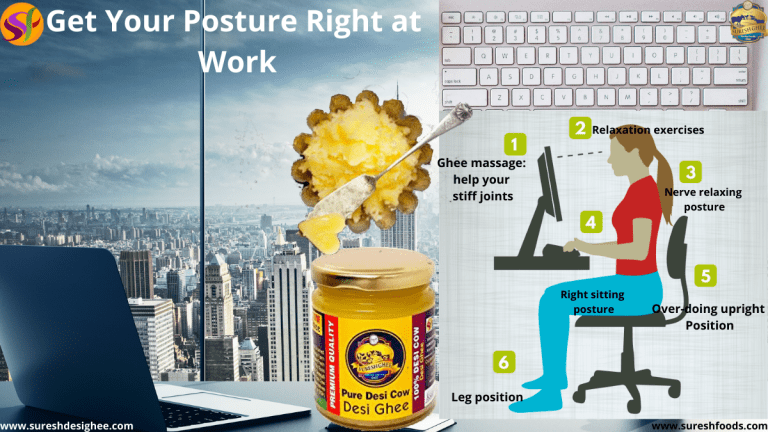Modern-day fast-moving lifestyle has given birth to major health concerns and a proper routine of exercise. As you spend a lot of time at your workplace, sitting like glue on the chair in front of a computer, it is essential that you work on healthy postures to prevent long-term health issues at bay.
Poor posture is not only bad for your back joints but also enhances your general temperament and perception of life. Here are some tricks you should get fit in mind while at work.
Ears and shoulder line rules
Make a balance between your ears in line with your shoulder. Dropping out is a common process at the office and you might get to know you are slouching right now while aware of this.
This is very dangerous as it takes a prolonged time period as it extricates your energy and it will impact your fortified spirit at the workplace. If you observe yourself bending far backwards or forwards usually, your posture will tumble up.
Whenever you sense that you are likely to be in a sliding position, Intentionally ensure your head is held line-up and your ears in a direct inline with your shoulders. This will resolve your pain by relieving the muscle tension that is present in knots near the shoulders.
Stretching
When you are working for long hours at your workplace continuously, your muscles feel cramped. It is essential that you work out your hands, legs, and your back every 1-2 hours by stretching it, as that stimulates blood circulation going.
Take a short break and work on some desk warm-up activities like wiggling your wrists and ankles or round rotation in both click-anticlockwise directions for your head. Small as they may be, these stretches have beneficial impacts on the body.
Check on the ailments like carpal tunnel syndrome. By the help of stretching arthritis issues due to old age and avoiding geriatric joint pain. You can move your head and neck clockwise and anti-clockwise to avoid tensions.
A common stretching activity you can involve in sitting in the front of your chair without affecting your back on the backrest of the chair. Balancing your lower back straight, use your right hand and stretch it tilted the left side of your chair’s backside and hold the chair.
Continue this position with your left hand as well. This simple practice will help the neurons along the side of the spine to arouse and get kicking, thereby offering you more freshness and activeness.
Read More : How to use ghee for various home remedies
1. Leg Position
The way in which you put your legs while you are functioning is incredible for your health. A good posture involves sitting upfront with your feet on the ground. Taking them widely apart before crossing your feet is a strict rule.
However, an uncomfortable situation found due to an odd chair or height difference regulates it hard to place on the ground. In this condition, you can use office props to climb your feet upwards, such as a small stool, a box of books, or a storage box. Some desks have a bar inclined to their base which makes it faster to beam your feet above it.
2. Over-doing upright Position
Endeavour to keep a right posture at the office, some people overdo the sitting upright exercise. It is true that balancing your backbone inline is a comfortable position, however, promotes your muscles rigid, and being sedentary in that posture for prolonged periods of time could actually lead to more issues.
The neck and shoulder muscles get strained when we overlap by stretching our back. You require to strike a suitable balance and find a posture that is neutral and that permits you to rest without slouching like a bag of clothes.
- Right sitting posture
By trying various sitting postures on your chair. Vary your buttocks at levels of the chair cushion and see how these make different positions feel comfortable. You might have to poke your chair away from your desk for this.
You can exercise this small level to understand the versatility between a straining posture and a comfortable one. Relax your lower back and sway your head low before you. Next, slowly bend your lower back,
Turn your shoulders forward and balance your head upright straight-up to your shoulders. This small activity will be useful for you to accept the neutral position that is appropriate for you. You can then yield in some relaxation exercises after you have procured that relaxing position.
- Relaxation exercises
Respiration practices are the effects to play in any given alternatives. Whenever you experience the bad vibes about the stress of the job that has got you immersed, you are able to hold your breath for a long time period, as though fetching a physical burden.
Deep breathing is a natural stress-buster as it helps to help out all the moldy, stack of air and generates a way for freshness and more calming air into your body and soul.
Sitting in front of your chair performing periodic deep breathing to inhale counting to 3 in your head. Repeat this by exhaling calmly at a count of 6. This helps to feel a state of coolness and relaxation.
- Standing Desks for Healthier Work Environments
In recent years, several scientific studies have showcased the long-term health benefits of standing desks, encouraging their role in elevating employee energy and concentration levels while minimizing the risk of health issues connected with prolonged sitting. The traditional sitting posture mostly results in an unnatural curvature of the spine, resulting in strain on neck and back muscles and potential injuries. Upgrading office equipment to involve standing desks provides the employees such flexibility to spend part of their day standing, relieving the pressure on the neck and back and encouraging the movement and a neutral spine position.
To elevate the benefits of a standing desk, it is suggested to comply with the 20:8:2 rule—20 minutes of sitting, 8 minutes of standing, and 2 minutes of movement. Setting reminders on your phone every 20 minutes can swiftly change posture and movement throughout the day.
Assuring that the standing desk is set to the appropriate height is beneficial for reducing the risk of injury. Adjust the desk in such a way so that your elbows form a 90-degree angle when standing comfortably upright and looking straight ahead. By positioning the monitor approximately an arm’s length away distance, with the top of the screen at eye level or just below. Conducting workplace training to support employees in transitioning from a sitting to a standing environment is imperative for assuring systematic uptake and compliance to correct strategy. This proactive approach supports the employees seamlessly integrating standing desks into their work routine, encouraging the entire well-being in the workplace.
Read More : 5 Reasons To Use Ghee To Transition Seasons
Massage with ghee to improve workplace posture
Getting a regular chair massage also strengthens your muscles and keeps soft tissues happy and can help you to keep your posture at work healthy. By straining out tight muscles and complicated areas as they need you to neglect to create a full-blown harness. Massage at work, even a 15-minute session, can stimulate the muscles of your spine, neck, and shoulders strong and healthy.
Ghee massage: help your stiff joints
Eating ghee can potently enhance bone strength. Ghee is a good source of vitamin K which is very essential for favourable assimilation of calcium in the system. Hence, not only calcium-rich nutrients but vitamin K-rich supplements are equal weightage. Ghee massage is used to treat disruption in pitta and Vata.
The ancient Susruta Samhita text affirms ghee is good for all constituents of the body, and it is the eventual overall remedy for pitta (inflammatory) issues and is the medium (Anupam) of alternative for infusing medicines for these circumstances.
Ghee massage is used to deal with ailments-related nerves, rejuvenating therapies, and aphrodisiac issues (vajikarana).
Furthermore, ghee is said to promote joint stiffness due to the wrong posture. We must be aware of modern science that ghee has phenolic antioxidants properties. It is good for the progression of all seven dhatus in the body (plasma, blood, flesh, fat, bones, marrow, semen) and is suited to folks of every age.
Ghee stimulates all sensory organs more effectively, In particular, it aids in the strengthening of bones and lubricates the healing of traumatic harms, including fractures, lubricates the connective tissues, and enhances flexibility.
Ayurveda Ghee massage – Nerve relaxing methods
Ayurveda massaging with grass-fed cow ghee can relax your muscles, veins, and central nervous system due to sitting for a long time in the wrong posture. The flow of arterial blood calculates how healthy and fit your system is.
Stress elements can obstruct the flow and break down. You require to find solutions for eliminating the obstacles and easing the circulations. Ayurvedic massages can relax the nerves and the veins linked to the spinal cord.
The massages can be done by using herbal oil, ghee, herbal powder, and paste. But ghee is an effective ingredient used from ancient times, it penetrates deep into the muscles, tissues, and nerves to provide complete relaxing results.
The methods may survive for a few days to a few weeks, based on the kinds and flexibility of muscular and nervous issues you have due to sitting in the wrong posture.
Conclusion
Pure desi ghee is recognized as an ideal ingredient for massaging. Massage mainly offers advantages to treat imbalance in pitta and Vata. Ghee plays a vital role to promote many benefits like fatigue or tension release due to wrong sitting habits, intelligence, quantity, quality of bone lubrications.
As ghee is enriched with antioxidants. Pure ghee can be made from the milk of a desi cow. In normal circumstances, desi cow’s milk ghee is the best choice for human use. If you store it is clean and water-free, desi ghee does not require refrigeration. If you want to buy desi ghee you can visit our website from where you can order it online: https://sureshfoods.com.







 WhatsApp us
WhatsApp us
Naveen m...